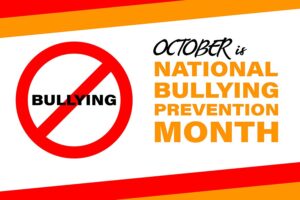Bullying is not a new phenomenon, nor is it restricted to just the elementary school playground. With the rise of social media comes a sharp rise in cyberbullying by children and adults alike toward their peers and strangers, too.
When is Bullying Prevention Month?
Every October, organizations nationwide observe National Bullying Prevention Month. Also known as World Bullying Prevention Month, this fall month when school is freshly back in session in the United States is dedicated to reminding students, teachers, administrators, and parents of the signs of bullying and how to handle bullying away from school.

Bullying Prevention Month was founded in October 2006 as just one awareness week hosted by PACER’s National Bullying Prevention Center. Now the month revolves around Unity Day, held on October 10, where people across the country wear orange to show support for bullied students everywhere.
Simply put, bullying is any intentional action that harms, intimidates, or coerces someone else. Bullying is aggressive and repetitive, often driving the recipient to depression, anxiety, post traumatic stress disorder, or even death by suicide. A 2019 study from the Centers for Disease Control and Prevention (CDC) showed about 20% of high school students had been bullied on school property in the last year.
There are three types of bullying: verbal, social, and physical. Teasing, taunting, spreading rumors, embarrassing someone in public, hitting, and pushing are all forms of bullying.
The Effects of Bullying on Mental Health
On average, 1 in every 5 children are bullied. According to the CDC, children who are bullied are more likely to experience low self-esteem, isolation, perform poorly in school, have few friends, and experience both physical and mental health struggles.
Bullied children, teens, and young adults often show signs of depression, anxiety, and low self-esteem. Even into adulthood, many bullying victims enjoy being alone and avoid social situations.
Minorities are often the target of bullying, especially the LGBTQ community. An overwhelming number of queer youth — 9 out of 10 — say they were bullied in school.
Bullying is a vicious disease that affects everyone it touches, including bystanders. Studies have shown students who witness bullying on the bus, in class, or in the hallways show increased anxiety and depression, even if they intervened in the bullying situation.
Even bullies themselves suffer from mental health issues associated with the intimidating behaviors. Bullies are at a higher risk of antisocial behaviors like substance abuse, aggressive behavior, and struggles at school. Whether it’s by older siblings or other children, many bullies are actually bully-victims who have been bullied themselves. While the behavior needs to be addressed and corrected immediately, it’s also important to remember the child’s needs, too.
How to Prevent Bullying
In 2006, the U.S. government rolled out StopBullying.gov to help create more awareness around the pervasiveness of bullying and publish resources to fight it at school and at home. The best bullying prevention is a mix of students, parents, teachers, and community members like law enforcement, religious organizations, and community action groups working together.
- Help kids understand bullying. Education is the key to prevention, and teaching children what to look for as bullying behavior is crucial. Use October as an annual reason to talk to your students, faculty, and children about how to stand up to a bully, when to tell an adult, and how to stay safe from a physical bully.
- Be a good role model. Bullying is often learned first at home. Instead of sarcastic jokes, focus on kindness and respect in front of children. Adults’ actions are always the best teachers for a child’s behavior.
- Always be open for communication. Children look to reassuring adults for advice and help. Even a small conversation every week that reassures kids they can talk to you, someone at home, or someone at school can keep the lines of communication open. Start conversations with open-ended questions like “What was a good thing and a bad thing that happened at school today?” or “What is it like to ride the school bus?” that encourage storytelling and details.
- The work starts at home. While educators are trained in how to handle bullying, many kids keep the aggressive treatment a secret from teachers and friends. If you see a change in your child, such as increased sadness, health complaints that keep them home from school, or a change in academic performance, talk to them about their friends and how they treat each other.
- Encourage kids to pursue their passions. Many children are mocked for their hobbies and often give them up because of peer pressure. When possible, find group activities like sports, youth groups, and school clubs where like-minded friends can often be found.
Contact Us Today
Bullying can cause lifelong damage, and the effects and ripple long into adulthood. If you were bullied as a child, or if your child is a bully, being bullied, or affected by bullying, we can help. Contact us to set up an appointment with one of our licensed therapists.

